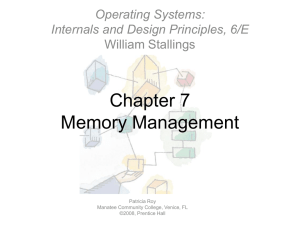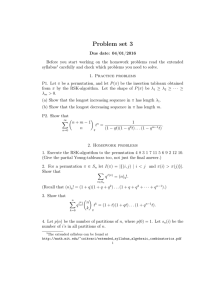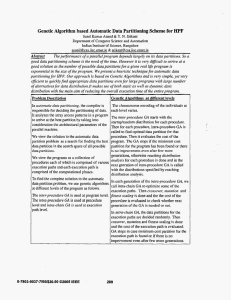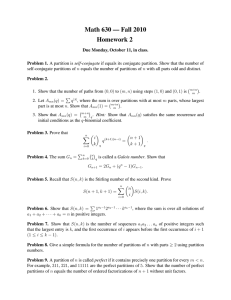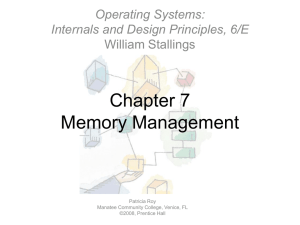Memory Management Chapter 7 1
advertisement
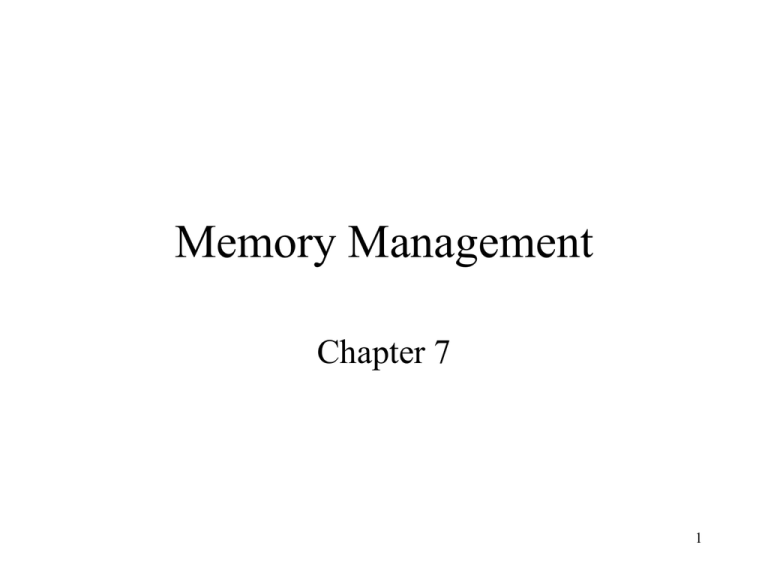
Memory Management Chapter 7 1 Memory Management • Subdividing memory to accommodate multiple processes • Memory needs to be allocated to ensure a reasonable supply of ready processes to consume available processor time 2 Memory Management Requirements • Relocation – Programmer does not know where the program will be placed in memory when it is executed – While the program is executing, it may be swapped to disk and returned to main memory at a different location (relocated) – Memory references must be translated in the code to actual physical memory address 3 4 Memory Management Requirements • Protection – Processes should not be able to reference memory locations in another process without permission – Impossible to check absolute addresses at compile time – Must be checked at rum time – Memory protection requirement must be satisfied by the processor (hardware) rather than the operating system (software) • Operating system cannot anticipate all of the memory references a program will make 5 Memory Management Requirements • Sharing – Allow several processes to access the same portion of memory – Better to allow each process access to the same copy of the program rather than have their own separate copy 6 Memory Management Requirements • Logical Organization – Programs are written in modules – Modules can be written and compiled independently – Different degrees of protection given to modules (read-only, execute-only) – Share modules among processes 7 Memory Management Requirements • Physical Organization – Memory available for a program plus its data may be insufficient • Overlaying allows various modules to be assigned the same region of memory – Programmer does not know how much space will be available 8 Fixed Partitioning • Equal-size partitions – Any process whose size is less than or equal to the partition size can be loaded into an available partition – If all partitions are full, the operating system can swap a process out of a partition – A program may not fit in a partition. The programmer must design the program with overlays 9 Fixed Partitioning • Main memory use is inefficient. Any program, no matter how small, occupies an entire partition. This is called internal fragmentation. 10 11 Placement Algorithm with Partitions • Equal-size partitions – Because all partitions are of equal size, it does not matter which partition is used • Unequal-size partitions – Can assign each process to the smallest partition within which it will fit – Queue for each partition – Processes are assigned in such a way as to minimize wasted memory within a partition 12 13 Dynamic Partitioning • Partitions are of variable length and number • Process is allocated exactly as much memory as required • Eventually get holes in the memory. This is called external fragmentation • Must use compaction to shift processes so they are contiguous and all free memory is in one block 14 15 Dynamic Partitioning Placement Algorithm • Operating system must decide which free block to allocate to a process • Best-fit algorithm – Chooses the block that is closest in size to the request – Worst performer overall – Since smallest block is found for process, the smallest amount of fragmentation is left – Memory compaction must be done more often 16 Dynamic Partitioning Placement Algorithm • First-fit algorithm – Scans memory form the beginning and chooses the first available block that is large enough – Fastest – May have many process loaded in the front end of memory that must be searched over when trying to find a free block 17 Dynamic Partitioning Placement Algorithm • Next-fit – Scans memory from the location of the last placement – More often allocate a block of memory at the end of memory where the largest block is found – The largest block of memory is broken up into smaller blocks – Compaction is required to obtain a large block at the end of memory 18 19 Buddy System • Entire space available is treated as a single block of 2U • If a request of size s such that 2U-1 < s <= 2U, entire block is allocated – Otherwise block is split into two equal buddies – Process continues until smallest block greater than or equal to s is generated 20 21 22 Relocation • When program loaded into memory the actual (absolute) memory locations are determined • A process may occupy different partitions which means different absolute memory locations during execution (from swapping) • Compaction will also cause a program to occupy a different partition which means different absolute memory locations 23 Addresses • Logical – Reference to a memory location independent of the current assignment of data to memory – Translation must be made to the physical address • Relative – Address expressed as a location relative to some known point • Physical – The absolute address or actual location in main memory 24 25 Registers Used during Execution • Base register – Starting address for the process • Bounds register – Ending location of the process • These values are set when the process is loaded or when the process is swapped in 26 Registers Used during Execution • The value of the base register is added to a relative address to produce an absolute address • The resulting address is compared with the value in the bounds register • If the address is not within bounds, an interrupt is generated to the operating system 27 Paging • Partition memory into small equal fixed-size chunks and divide each process into the same size chunks • The chunks of a process are called pages and chunks of memory are called frames • Operating system maintains a page table for each process – Contains the frame location for each page in the process – Memory address consist of a page number and offset within the page 28 Assignment of Process Pages to Free Frames 29 Assignment of Process Pages to Free Frames 30 Page Tables for Example 31 Segmentation • All segments of all programs do not have to be of the same length • There is a maximum segment length • Addressing consist of two parts - a segment number and an offset • Since segments are not equal, segmentation is similar to dynamic partitioning 32 33 34 35


